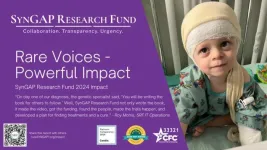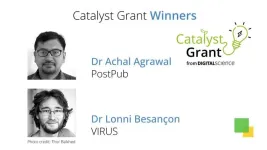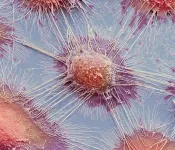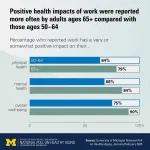(Press-News.org) Mill Valley, CA – February 11, 2025 – The SynGAP Research Fund 501(c)(3) dba Cure SYNGAP1 proudly announces the release of its inaugural Impact Report, a transparent and celebratory reporting of tangible goals achieved and purposeful progress made in 2024 by this growing and dynamic organization led entirely by families and driven by volunteers. With a mission rooted in improving the lives of SYNGAP1 patients, and built upon the promises of Collaboration, Transparency and Urgency, SRF’s 2024 Impact Report provides stakeholders – including families, scientists, and donors – a thorough and extensive look at the incredible achievements the organization has made in accelerating research, collaborating with academy and industry to develop medicine for SYNGAP1-related disorders (SRD), activating the patient community, and engaging in public policy to ensure patients and families living with SRD have a voice in creating a more accessible, accommodating, and just world.
Like everything else SRF does and stands for, the Impact Report is a labor of love; a triumphant declaration of promises made, promises kept; a call to continued action, and an invitation to seize the opportunity to join its far-reaching, meaningful mission; a testament to SRF’s laser-focused and unwavering commitment to finding treatments and a cure for SYNGAP1-related disorders.
SRF Co-Founder and Managing Director Mike Graglia has no doubts about the impact the organization is having. As a parent of a son with SYNGAP1, he knows there is no time to waste, because, “Time is brain. I believe we are making a meaningful impact, and our work is valuable. I know several researchers who would not be focused on SYNGAP1 or would not be as far along without our support. Companies who are presently close to trials have conveyed to me what a difference SRF’s iPSCs and rapid information sharing have made in their decision to prioritize SYNGAP1. So many families have better care because of the support of this community. Multiple studies include SYNGAP1 because SRF was able to recruit patients into them rapidly.”
Accelerating Research
To fully illustrate the enormity of SRF’s commitment to funding research initiatives, and the critical scientific outcomes the organization facilitates, the Impact Report outlines the Seven Core Scientific Programs that reflect the organization’s urgency to drive breakthroughs and secure successful treatments. Each program – including basic and translational science, drug repurposing, SYNGAP1 missense research, biomarkers, endpoints, research reagents, SYNGAP1-related disorders characterization, and a first-of-its-kind SYNGAP1 Natural History study at multidisciplinary clinics – serves a crucial role in accelerating genetic and translational science research, with a combined 51 grants funded totaling over $6 million dollars since the Fund was established in 2018.
“SRF has committed more than $6M to SYNGAP1-related disorders (SRD) science, guided by a world-renowned Scientific Advisory Board of SYNGAP1 researchers. We’ve made strategic investments … repurposed drugs, ASOs, and gene therapies. SRF’s creation of an ICD-10 code, publishing of a quarterly SYNGAP1 Census, investing in Citizen Health’s digital natural history study, and hosting of an annual scientific conference are all vitally important, without which SYNGAP1 would not be where it is on the path to treatments,” says Peter Halliburton, a SYNGAP1 dad, who serves on the SRF Board of Trustees.
Collaborating to Develop Medicine for SYNGAP1-Related Disorders
For patients, families, and caregivers living with SYNGAP1-related disorders, who must navigate core disease features such as epilepsy, intellectual disability, autism spectrum disorder, and maladaptive behaviors – as well as challenges with sleep, speech, eating, GI distress, psychiatric comorbidities, gait problems, hypotonia, and sensory processing issues – there is no time to waste in the search for viable treatments and effective cures. Collaborating with academia and industry to develop medicines for SYNGAP1-related disorders has resulted in an active SRD pipeline, built upon four pillars designed to ensure clinical trial readiness: natural history studies, SYNGAP1 biomarkers and endpoints, regulatory engagements , and patient recruitment. Investing in these four pillars is vital to de-risk and optimize clinical trial design, making it possible to illuminate and accelerate the path to successfully treat and cure SYNGAP1.
“At SRF, we’ve built a reputation as a trusted partner, forging strong alliances with academic institutions and pharmaceutical companies to accelerate SYNGAP1 research. Together, we’re putting SYNGAP1 on the map and driving progress toward a cure. Collaboration and open communication are at the heart of our approach, enabling us to exchange knowledge, overcome challenges, and move faster—because we know we can’t do this alone. We deeply value our partners and a shared commitment to changing lives.” – Virginie McNamar, SYNGAP1 parent, SRF President and COO
Activating the SYNGAP1 Patient Community
One of SRF’s most vital achievements has been to grow, educate, support, and activate the SYNGAP1 patient and family community. For Summer Slaught – parent, SRF volunteer, and former Board Member – the organization has been an integral part of her family’s ability to navigate living with SYNGAP1. “SynGAP Research Fund has provided our family with a wealth of knowledge and a positive community that is supportive, caring, engaged, and available to one another.”
The inevitable feelings of isolation and overwhelm that occur during a rare disease diagnosis are often exacerbated by difficulties accessing essential supports and resources under significantly strained systems, as well as a shortage of accessible information that may translate to potentially life-changing opportunities for patients and meaningful connections for families and caregivers. Recognizing that a robust patient community is essential for securing early diagnosis and intervention, building a support network, advancing research and data collection, and increasing advocacy and awareness, continues to be the catalyst for SRF to prioritize building a strong, resilient, collaborative SYNGAP1 community with worldwide reach.
By investing in and mobilizing the power of social media, awareness campaigns, informative webinars and weekly podcasts, newsletters, census collaboration with international partners, family zoom calls, in-person meet-ups, a state Ambassador program, securing an ICD-10 code, and organizing an annual conference, SRF is determined to include every single SYNGAP1 patient, these courageous warriors who are the very heartbeat of SRF, and are the purpose behind everything it does and stands for.
“It’s truly incredible to witness the collective effort and commitment to a common goal. Volunteering with SRF has not only been a lifeline for my family, but also a pathway to impact the lives of countless others affected by rare diseases,” says Corey Baysden, parent and SRF Community Activation Director.
Advocating and Engaging in Public Policy
Harnessing the power of the unique strengths and collective voices of the SRF community has propelled the organization to become a powerhouse in rare disease advocacy, providing critical representation at public policymaking tables. Through state-specific resources, direct patient advocacy, engaged leaders driving meaningful change, advocacy training opportunities for families, and participation in EveryLife Foundation’s Community Congress, SRF uses its expanding platform to ensure the experiences of patients and families living with SYNGAP1 are heard and heeded.
SRF’s Ambassadors and Advocates Program serves a vital role in fostering a supportive environment. Ambassadors welcome newly diagnosed families to ensure they know they are not alone, providing resources and basic information to those who are just learning what SYNGAP1 is and how their lives have changed overnight. For those seeking assistance in navigating often complex state programs, state advocates assist in connecting families to state-specific services, as well as provide guidance in developing an Individualized Education Program (IEP).
For Jackie Kancir, parent and SRF Patient Advocacy Director, a better life tomorrow for those living with SYNGAP1, begins with fearlessly advocating for change today. “Advocates are indefatigable dreamers who reject despair in the face of inequity. By breaking barriers and transforming the remnants of dismantled injustice, they lay the foundation of smoother pathways for generations to come.”
As a marginalized and vulnerable population, the rare disease community – and those living with SYNGAP1-related disorders in particular – deserves nothing short of accurate representation of its diverse and affected population. “The SynGAP Research Fund believes that diverse perspectives enhance our research efforts. We are committed to ensure that all individuals, regardless of their background, have access to resources, opportunities, and support in our pursuit of advancing treatments for and understanding of SYNGAP1,” says Victoria Arteaga, Director, SRF Latin America.
Raising Funds and Building Community
There is a determined and hopeful parent, caregiver, and loved one behind every dollar raised for SRF. A beloved patient inspires every fundraiser initiated, every event organized. Each goal declared, reached, and surpassed is driven by the dream of finding treatments and a cure for SYNGAP1-related disorders. Thanks to the tireless efforts of families, volunteers, donors and collaborators, that dream is quickly approaching reality, as SRF prepares for the inevitability of clinical trials, closer now than ever before.
Eric Moulton, a parent who serves on the SRF Board of Trustees, knows firsthand the hard work it takes to bring a fundraising vision to life. “Although planning for and hosting the (Sprint4Syngap) event was physically and emotionally taxing, it was undoubtedly a success. We strengthened our local SYNGAP1 community, raised awareness about SRD, and most importantly, raised funds to help accelerate therapies for our kids.”
For many in the community, connection is often virtual, as families remain busy with providing care for their loved ones with SYNGAP1 – medical appointments, evidence-based therapies and interventions, advocating for individualized education programs, managing maladaptive behaviors, and negotiating a minefield of applications and wait-lists for desperately needed services, supports, and resources. These make up a full-time job with endless overtime hours and little to no respite in sight. It is once a year, at the Annual SRF Conference, where patients and families can finally meet in person – often for the very first time – and feel the full power and unconditional support of the organization and the SYNGAP1 community. Demonstrating the power of combining scientific innovation with patient and family connection, each conference fosters a brighter future for those impacted by SYNGAP1.
Looking Ahead
If there’s one takeaway from SRFs inaugural Impact Report, it’s that another will undoubtedly follow. What better way to proudly display the substantial merits and verifiable performance of this little engine that could than with an all-access, behind-the-scenes results portfolio. Since its founding in 2018, SRF has proven it doesn’t waste time, resources, or money, a game plan that’s thrust its vision well beyond an earnest pledge and manifested its mission into sustainable and thriving action.
The future? According to SRF, it’s already here, less bleak and more hopeful than ever, as it races towards the next finish line, fueled by the SYNGAP1 patients it’s vowed to save, supported by the families who believe it.
About SYNGAP1-Related Disorders (SRD)
SYNGAP1-related disorders (ICD-10 F78.A1) is a rare genetic disorder caused by variants on the SYNGAP1 gene that reduce SYNGAP1 protein levels. SRF has identified over 1,530 patients to date, and the number grows weekly. This protein acts as a regulator in the synapses (where neurons communicate with each other). When SYNGAP1 protein levels are too low, we see an increase in excitability in the synapses making it difficult for neurons to communicate effectively. This leads to many neurological issues seen in SYNGAP1 patients.
Symptoms of SRD include primarily neurological issues including autism spectrum disorder (ASD), intellectual disability, epilepsy, hypotonia (low muscle tone), gross and fine motor delays, global developmental delay, and visual abnormalities such as strabismus (crossed eyes) as well as gastrointestinal challenges and disordered sleep.
About the SynGAP Research Fund
The mission of the SynGAP Research Fund (SRF) dba Cure SYNGAP1 is to improve the quality of life for SYNGAP1 patients through the research and development of treatments, therapies, and support systems.
SRF was founded in the US in 2018 as a 501(c)(3) US public charity. There are sister organizations founded by local families in the UK in 2020, Europe (Netherlands) in 2022, as well as both Australia & Latin America (Colombia) in 2023.
Completely family-led, SRF is a leading funder of SYNGAP1 research having committed over $6.2 million in grants to date. SRF’s grant program awards one or two-year grants to investigators, physician residents, and clinicians interested in studying SYNGAP1. SRF grants are intended to help researchers explore novel ideas and answer open questions related to the clinical aspects of and therapies for SRD.
For more on SRF, visit cureSYNGAP1.org or follow @cureSYNGAP1 on LinkedIn, YouTube, Instagram, Facebook, TikTok, or X.
SRF is a member of FasterCures, COMBINEDBrain, Global Genes Foundation Alliance, Everylife Foundation Community Congress, Epilepsies Action Network, Personalized Medicine Coalition, Rare Epilepsy Network, Epilepsy Leadership Council, Alliance for Genetic Etiologies in Neurodevelopmental Disorders and Autism (AGENDA), California Action Link for Rare Diseases, American Brain Coalition, Genetic Alliance UK, Rare Disease UK, Syndromes Without a Name (SWAN UK), Jumpstart Program, Patient Worthy, Autism Brain Net, Innovation and Value Initiative, Rare Disease Diversity Coalition, Cambridge Rare Disease Network, Breaking Down Barriers, Rare-X, Mencap, IndoUSRare, and The World Orphan Drug Congress.
END
SynGAP Research Fund dba cure SYNGAP1 (SRF) announces the release of their SYNGAP1 impact report for 2024
With a mission rooted in improving the lives of SYNGAP1, SRF’s 2024 Impact Report provides stakeholders - including families, scientists, and donors - a thorough and extensive look at the incredible achievements the organization has made
2025-02-11
ELSE PRESS RELEASES FROM THIS DATE:
Breakthrough in click chemistry: innovative method revolutionizes drug development
2025-02-11
Middle molecules with a molecular weight of more than 1,000 are difficult to synthesize due to multiple steps and time-consuming nature, demanding the development of a new approach that can overcome these disadvantages. Click chemistry has become an essential tool in applied chemistry due to its simplicity, efficiency, and versatility. This approach to chemical synthesis allows for quick and reliable joining of small molecules into larger, more complex structures, often with minimal side reactions and byproducts. By definition, click chemistry reactions are highly selective and efficient, making them ...
Digital Science announces Catalyst Grant winners, rewarding innovations to safeguard research integrity
2025-02-11
Digital Science has awarded its latest Catalyst Grants to two innovative teams, supporting their technology ideas aimed at safeguarding research integrity and strengthening trust in science.
The winners will use the funding and mentorship from Digital Science to develop their ideas, both of which include enhanced dashboards – visualizations based on available data – to flag retracted or questionable research papers.
The winning applications from Digital Science’s 2024 Catalyst Grant round announced today are:
PostPub ...
How cancer cells trick the immune system by altering mitochondria
2025-02-11
The immune system plays a key role in detecting and destroying cancer cells. Cancer immunotherapy works by programming immune cells to recognize and eliminate cancer cells. However, many cancers can escape immune surveillance through various mechanisms, resulting in resistance to treatment. This highlights the need to better understand the molecular processes that enable immune evasion.
The tumor microenvironment (TME)—the space surrounding a tumor—plays a critical role in interactions between cancer and immune cells. Cancer cells can reshape the TME to ...
Poll: Most U.S. workers with chronic conditions manage them at work, haven’t told employer
2025-02-11
Embargoed for release: Tuesday, February 11, 2025, 6:00 AM ET
Key points:
More than half of employees in the U.S. (58%) report having physical chronic health conditions, such as hypertension, heart disease, diabetes, and asthma, according to a new nationally representative survey.
Three-fourths of U.S. employees with chronic conditions (76%) need to manage their conditions during work hours, yet a majority (60%) have not formally disclosed their conditions to their employer.
More than one-third of U.S. employees with chronic conditions (36%) say they have skipped medical appointments or delayed getting care to avoid ...
Disruption of a single amino acid in a cellular protein makes breast cancer cells behave like stem cells
2025-02-11
UNDER STRICT EMBARGO UNTIL TUESDAY 11 FEBRUARY 2025, 11am (UK time)
Disruption of a single amino acid in a cellular protein makes breast cancer cells behave like stem cells
Peer reviewed | Observational | Cells
Changes to the intermediate filament (IF) protein, vimentin, were found to promote tumour growth by increasing cancer stemness in an oestrogen independent manner. Targeting vimentin and/or the long noncoding RNA (lncRNA) ‘XIST’ could be an effective therapeutic strategy ...
As more Americans work later in life, poll shows positive health impacts, especially for those over 65
2025-02-11
Having a job – whether it’s working for someone else or being their own boss – gives older Americans more than just a way to earn money or get health insurance, a new poll finds.
More than two-thirds of those who work after age 50 say that working boosts their physical health, mental health, and/or their overall wellbeing, according to a new report from the University of Michigan National Poll on Healthy Aging.
Nearly half (46%) of those who work say that having a sense of purpose is a very important ...
Is the Metaverse a new frontier for human-centric manufacturing?
2025-02-11
Is the Metaverse a new frontier for human-centric manufacturing?
The future of manufacturing is not just about machines and AI; it's about re-empowering humans, according to a new study from the University of Surrey.
The integration of advanced technologies like augmented reality (AR) and digital twins is set to redefine the workforce's role, making humans an essential part of the manufacturing equation once again.
The paper, published in Sustainability, explores the transformative potential of Metaverse technologies ...
When qubits learn the language of fiberoptics
2025-02-11
Qubits—the fundamental units of quantum information—drive entire tech sectors. Among them, superconducting qubits could be instrumental in building a large-scale quantum computer, but they rely on electrical signals and are difficult to scale. In a breakthrough, a team of physicists at the Institute of Science and Technology Austria (ISTA) has achieved a fully optical readout of superconducting qubits, pushing the technology beyond its current limitations. Their findings were now published in Nature Physics.
Following a year-long rally, ...
The prevalence of older Americans without disabilities increases substantially between 2008 and 2017
2025-02-11
Toronto, ON – A sizeable improvement was found in the prevalence of American adults aged 65 and older without disabilities -- including memory, hearing, visual, and functional disabilities or limitations in activities of daily living -- according to a new nationally representative study published online in the Archives of Gerontology and Geriatrics Plus found.
In total, 61% of older Americans reported being free from disability in 2008. The prevalence increased to 65% in 2017. While this may seem like a small increase, had the prevalence of individuals without disabilities remained ...
New study reveals hidden manic symptoms in one-fourth of schizophrenia patients
2025-02-11
THESSALONIKI, Greece, 11 February 2025 - In a notable Genomic Press research report, researchers at the Aristotle University of Thessaloniki have uncovered a significant presence of manic symptoms in patients with schizophrenia spectrum disorders (SSDs), offering valuable insights that could reshape treatment approaches.
The rigorous peer-reviewed study, published in Brain Medicine, examined 75 stable outpatients with SSDs, revealing that more than one in four patients (26.7%) exhibited distinct manic symptoms, a finding that ...
LAST 30 PRESS RELEASES:
Making lighter work of calculating fluid and heat flow
Normalizing blood sugar can halve heart attack risk
Lowering blood sugar cuts heart attack risk in people with prediabetes
Study links genetic variants to risk of blinding eye disease in premature infants
Non-opioid ‘pain sponge’ therapy halts cartilage degeneration and relieves chronic pain
AI can pick up cultural values by mimicking how kids learn
China’s ecological redlines offer fast track to 30 x 30 global conservation goal
Invisible indoor threats: emerging household contaminants and their growing risks to human health
Adding antibody treatment to chemo boosts outcomes for children with rare cancer
Germline pathogenic variants among women without a history of breast cancer
Tanning beds triple melanoma risk, potentially causing broad DNA damage
Unique bond identified as key to viral infection speed
Indoor tanning makes youthful skin much older on a genetic level
Mouse model sheds new light on the causes and potential solutions to human GI problems linked to muscular dystrophy
The Journal of Nuclear Medicine ahead-of-print tip sheet: December 12, 2025
Smarter tools for peering into the microscopic world
Applications open for funding to conduct research in the Kinsey Institute archives
Global measure underestimates the severity of food insecurity
Child survivors of critical illness are missing out on timely follow up care
Risk-based vs annual breast cancer screening / the WISDOM randomized clinical trial
University of Toronto launches Electric Vehicle Innovation Ontario to accelerate advanced EV technologies and build Canada’s innovation advantage
Early relapse predicts poor outcomes in aggressive blood cancer
American College of Lifestyle Medicine applauds two CMS models aligned with lifestyle medicine practice and reimbursement
Clinical trial finds cannabis use not a barrier to quitting nicotine vaping
Supplemental nutrition assistance program policies and food insecurity
Switching immune cells to “night mode” could limit damage after a heart attack, study suggests
URI-based Global RIghts Project report spotlights continued troubling trends in worldwide inhumane treatment
Neutrophils are less aggressive at night, explaining why nighttime heart attacks cause less damage than daytime events
Menopausal hormone therapy may not pose breast cancer risk for women with BRCA mutations
Mobile health tool may improve quality of life for adolescent and young adult breast cancer survivors
[Press-News.org] SynGAP Research Fund dba cure SYNGAP1 (SRF) announces the release of their SYNGAP1 impact report for 2024With a mission rooted in improving the lives of SYNGAP1, SRF’s 2024 Impact Report provides stakeholders - including families, scientists, and donors - a thorough and extensive look at the incredible achievements the organization has made






